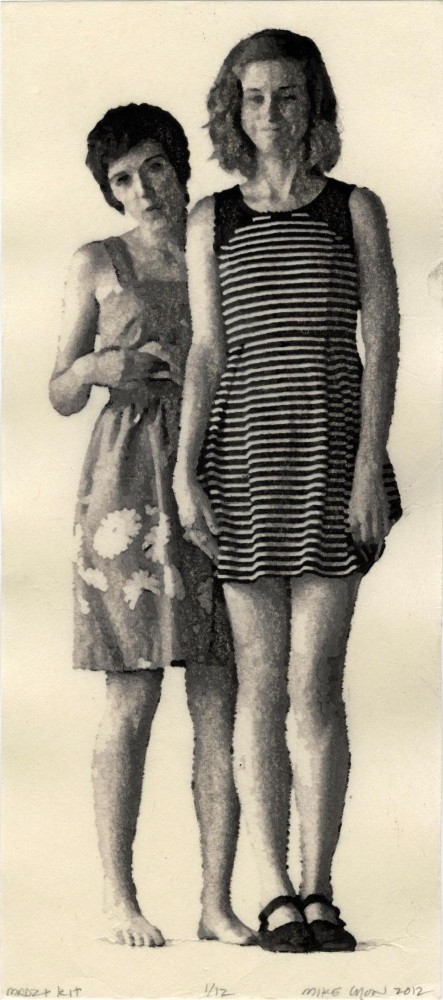g&e
Grabado Y Edicion Print and Art Edition Magazine, No. 36, December, 2012

Mike Lyon, Madz and Kit (2012), 13 x 5.7 inches from 17 blocks on lwano lchibel hosho. Edition of 12. Printed by the artist. Published by the artist.
Processes: Mokuhanga
Sosaku Hanga: Creative Prints
by April Vollmer
Sosaku hanga is usually translated as creative prints, and is used to describe Japanese printmakers during the first half of the 20th century who cut and printed their own blocks. Within Japan the sosaku hanga printmakers were regarded as serious creative inheritors of the individualistic ukiyo-e artists. The new generation of art1sts considered the carving marks as part of the finished expression.
The beginning of this kind of printmaking is considered to be the “Fisherman” print of Kanae Yamamoto, published in 1904. Yamamoto was one of a community of artists who incorporated new ideas from the West in their work. Other artists were Unichi Hiratsuka, Koshiro Onchi, Kiyoshi Saito and many more. While these artists were not as well known outside Japan as the shin hanga artists, their prints are an expression of Japanese creative artists who incorporated new ideas from the West without relinquishing the Japanese foundations of their art.
Munakata is an example of an artist who adopted a creative, free approach to carving, while maintaining his connection to the mythology of Japan. He used Japanese paper and Japanese imagery of Buddhist gods and goddesses to make contemporary work that crossed boundaries, combining traditional materials with a modem outlook.
Contemporary Mokuhanga
With the rise of universities in 20th century Japan, young artists began to train as students in universities rather than as apprentices in workshops. Influenced by Western models, printmaking departments emphasized the oil based techniques of etching and lithography. Water-based woodblock was considered old-fashioned, suitable for children, or for year-end greeting cards. Fortunately, there were a few artist-educators who maintained an interest In woodblock. Some cultivated connections with the remain1ng hanmoto printshops. In Kyoto, abstract artist Akira Kurosaki trained a new generation of master artist printers at Kyoto Seika University. In Tokyo, Tetsuya Noda, whose work combines woodblock with autobiographical photographic imagery, taught mokuhanga at Tokyo Geidai University. Japanese woodblock came to the attention of the contemporary art world in the 1980s with Kathan Brown’s decision to take Crown Point Press artists to Japan to work with master printer Tadashi Toda. She published mokuhanga prints there with such well-known artists as Pat Stelr, Chuck Close, and Robert Kushner. Her collaboration with master printer Tadashi Toda brought awareness of the possibilities of the technique to contemporary Western artists. It also inspired Keiko Kadota to create a training program for foreign artists called the Nagasawa Art Park program. Tadashi Toda helped her train artists before his death in 2000. The program closed In 2012, and Kadota has opened a new residency near Tokyo called Mi-Lab (Mokuhanga lnnovation Laboratory). The residency was designed to introduce foreign artists to mokuhanga. and has had a broad influence outside Japan because so many of the residents have shared their experience with students and colleagues in their home countries.
Today mokuhanga is practiced by artists not only in Japan but around the world, in the US, Europe, Flnland, Australia, and many other locations. It has gained popularity because of its adaptability to creative use. It can be practiced without a press. needs only water as a solvent, and offers easy registration and rich color. Mokuhanga can be used to print many colors without obscuring the surface off the Japanese papers. Artists trained in Japan like Takuji Hamanaka, teaching privately. or Yasu Shibata, master printer at Pace and teacher at Cooper Union in New York, are teaching a new generation of printmakers outside Japan. Aalto University in Finland has a mokuhanga program created by Finnish artists Tuula Moilanen and Kari Laitinen. Karen Kunc at the University of Nebraska has Incorporated mokuhanga in her work and teaching. Artists have used mokuhanga in new ways. Mike Lyon (US) has developed a way of using computer-driven routers to cut the blocks he uses for mokuhanga printing. Katie Baldwin (US) creates installations that incorporate mokuhanga. Michael Schneider (Austria) creates and prints his blocks as a performance documented by the finished print. In September of 2014 the Second International Mokuhanga Conference will be held at Tokyo Geidai University.
Information will be available at www.mokuhangajp/en/ .
April Vollmer is an artist with an MFA from Hunter College, NYC, who specializes in Japanese woodblock printmaking. She has taught workshops in mokuhanga at the Lower East side Printshop since 1998, and at many printshops across the US. She has worked with the Nagasawa Art Park Program, and again in 2011 as a board member of the First International Mokuhanga Conference.